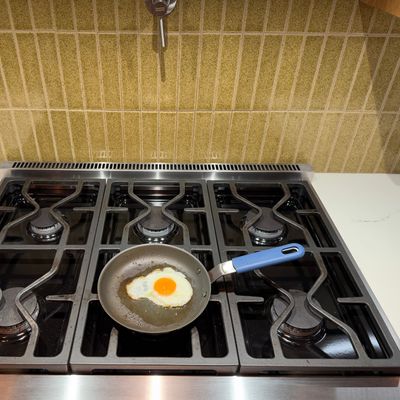
For at least 15 years now, I’ve lived grudgingly with nonstick pans. I have cast-iron (enameled and not) and stainless-steel-clad skillets, but I regularly cook many things that benefit from the slick, acid-resistant interior and lightweight, easy-to-flip form factor of nonstick. It’s just one of the most convenient options, the easiest to clean and maintain. (The ability to cook without fat is not one of the selling points for me.)
That said, it always feels so wasteful to throw one out when the coating wears off or it gets scratched up — as it inevitably does, no matter how careful I am to hand-wash it, not to overheat it, or to keep it away from metal utensils. I’ve held onto some for too long, willfully overlooking the increasingly discolored cooking surface, the multiplying pits and scars, and whatever bad things those were doing to me.
I tried ceramic nonstick when that was a new thing and bought an expensive Danish pan that promised to be more durable and also to withstand higher temperatures than other nonstick pans.
But, as many other people also discovered, ceramic nonstick is no better than regular nonstick, and that pan also ended up in the trash. So then I resigned myself to the short lifecycle of the cheap but very good Tramontina Professional Aluminum Nonstick Skillet. It’s lasted me about five years at a stretch, but I knew there had to be a better option.
And there was — sort of. When I first learned about carbon-steel pans a decade ago, they felt aspirational. They were mostly used in professional kitchens and didn’t come pre-seasoned. Or if they did, the seasoning wasn’t very good. (Like cast iron, carbon steel requires special maintenance to keep it usable and useful.) Certainly not good enough to be a nonstick replacement. I had never been able to achieve a super-slick seasoning on my Lodge cast iron, and the most highly regarded carbon-steel pans, made by de Buyer and Mauviel, were $100 — steep if you’re not confident in your seasoning skills.
I finally took a chance on an unseasoned carbon-steel pan from Misen, its first, which the company launched on Kickstarter. And when the ten-inch pan arrived back in 2020, I let it sit unused for several years because removing the protective wax coating and having to season it seemed way harder than continuing to use my nonstick. (Earlier this year, my mom, mistaking it for a nonstick pan, accidentally used it to stir-fry some noodles, which was a disaster. I tried half-heartedly to season it, but that’s a project for another time; it remains a sticky pan.)
In the past few years, I’d been hearing that pre-seasoned carbon steel had come a long way. I bought an eight-inch pan from Made In this year but should have realized it was not the right one for me when the instructions that came with it said not to fry eggs with it until it had built up more of a seasoning. I tried pan-frying dumplings; all the wrappers stuck. This pan was not a nonstick replacement.
Still hopeful, I outsourced further research to contributor Michael Zhao, assigning him our guide to carbon-steel pans. The initial results he shared were genuinely exciting: He sent me videos of crispy-edged fried eggs sliding frictionlessly around in the pans he was testing, along with the compelling note, “Just a little butter.” One of the important tips Zhao gave me is that you have to heat the pan moderately, then put the cooking fat in so that it’s just shimmering, not smoking; if you heat up the oil first or overheat the pan, food will stick.
I was surprised when Zhao’s top pick ended up being Misen’s pre-seasoned pan, since that original pan from the brand hadn’t worked out for me (and it doesn’t seem to carry an unseasoned version now). But I couldn’t deny his results, so when Misen had a sale, I went ahead and bought eight-inch and 12-inch pans (maybe someday I’ll strip and properly season that ten-inch Kickstarter one).
When the pans arrived, I put the larger one immediately to the test, frying an egg first, then cooking a pan full of potstickers, all of which slid off without a hitch. Since then, I’ve pan-roasted Brussels sprouts, broccoli, and salmon, made fried rice, and cooked pancakes and many more eggs in them. (You can’t cook acidic foods in carbon steel, but for those I have enameled cast iron.)
To clean them, I give them a scrub with a soapy sponge, then rinse, and if anything’s crusted on, I might use some chain mail to gently pry it off. I’ve only seasoned the pans once (using Misen’s wax; I haven’t loved the results I’ve gotten in the past with grape-seed oil) and haven’t felt the need to do it every time I use them. I also haven’t felt the need to use my nonstick pans since.
The Strategist is designed to surface useful, expert recommendations for things to buy across the vast e-commerce landscape. Every product is independently selected by our team of editors, whom you can read about here. We update links when possible, but note that deals can expire and all prices are subject to change.












